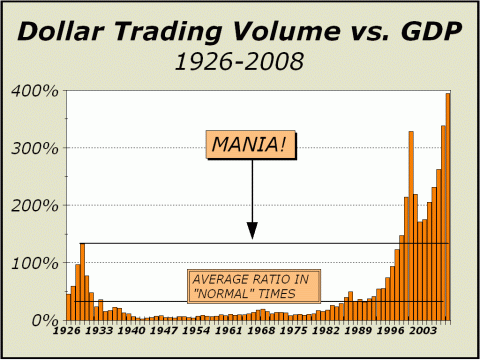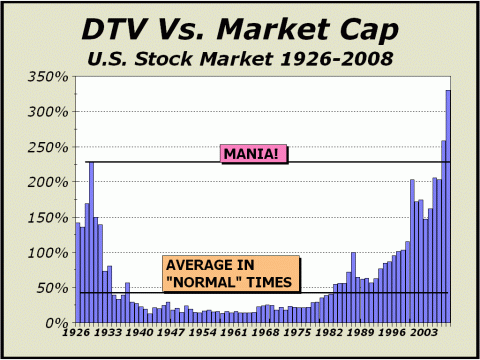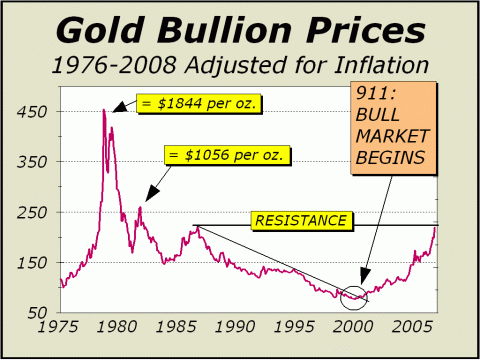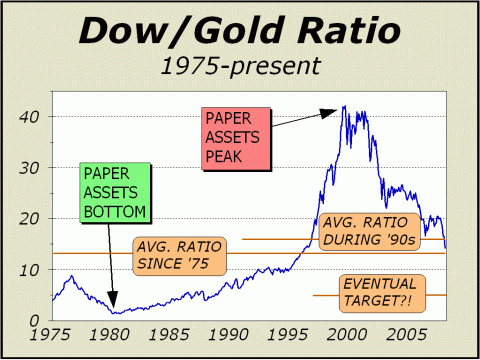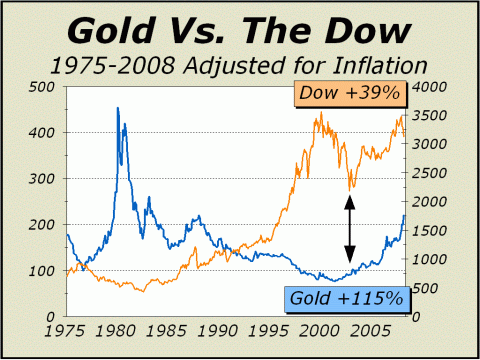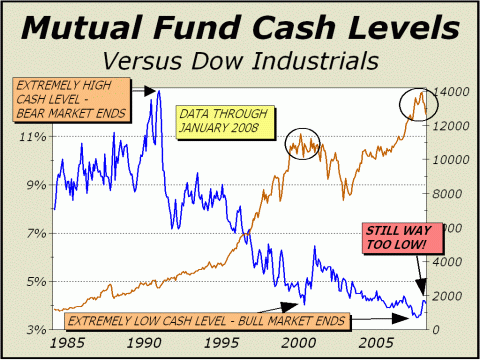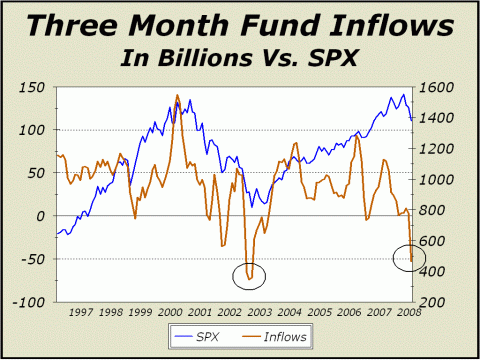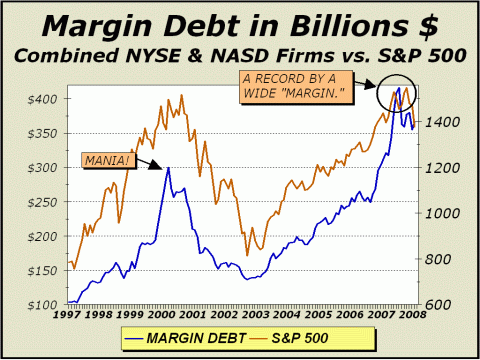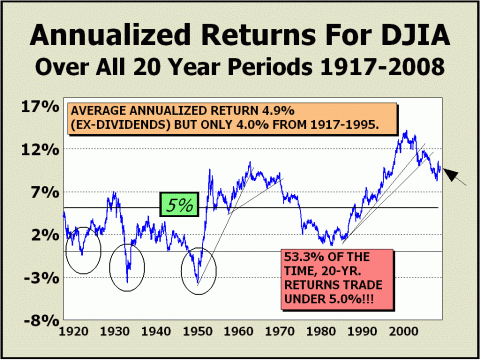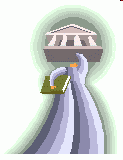
|
- THE GREATEST STOCK MARKET MANIA
OF ALL TIME -
DATED MAY 4, 2008 A SPECIAL REPORT BY ALAN M. NEWMAN, EDITOR CROSSCURRENTS This feature is now published on roughly a quarterly basis. Our next update will likely be published in mid-to-late August 2008. |
|
A world map of readers from 163 countries can be viewed HERE. Run your mouse over each country! This report is now mostly a compilation of articles that have previously appeared in the Crosscurrents newsletter. Our paid subscription stock market newsletter has only two rationales for its existence; powerful commentary and unique perspectives that cannot be found anywhere else. Please check out the testimonials on our Kudos page. To see a free sample copy of the Crosscurrents newsletter, CLICK HERE Printable
files of this report are available only to paid subscribers.
As the most recent months have unfolded, it has been increasingly clear that our forecasts of a derivative crisis were both pertinent and correct. We urge you to visit the archives where many of our past reports were linked in the January 2008 issue of Pictures of A Stock Mania. While the problems appear to have abated somewhat for the time being, the threats are still in place. To date, financial companies have lost or written off more than $300 billion. If our previous analysis is correct, we may be only a fraction of the way towards an eventual resolution and reversal. Stay tuned. In the meantime, the sheer velocity of stock trading implies we are in a terminal stage for paper assets.
As far back as one year ago, so-called "Dark Pools" accounted for 17% of New York Stock Exchange market share. The pools seek to reduce the costs of trading for clients by crossing orders in their proprietary books, without publishing the quotes. Theoretically, pricing is improved and the proprietors earn higher commissions. Supposedly, a win win scenario. However, all we see is the further Frankenstein-ization of the U.S. stock market, another step in opacity and yet another market mechanism that draws assets from investment mode to trading mode. When monies are "invested" as opposed to "traded," valuations are of primary importance. When monies are "traded" rather than invested, short term considerations are paramount. Benjamin Graham and David Dodd literally wrote the book on security analysis (see http://tinyurl.com/3hlrue). Their principals enabled investors to determine a fair value for securities for decades, but the practice has been rapidly losing adherents since the mania first drew its first breath of life in 1995. As trading has proliferated, the velocity of dollar volume has expanded so significantly that it dwarfs any comparisons to the past. Another new record was established in 2007 and at the pace of the first three months in 2008, yet another new record will be established this year, far exceeding 2007. Relative to the country's gross domestic product, trading velocity is now three times the pace of 1929. Interestingly, the stock market is no longer just a market of stocks; it is a market ruled by derivatives of the securities that make the market possible in the first place. The tail completely wags the dog. Bear in mind that the statistics shown in our charts do not include stock options, which generate additional trading on their own specific requirements for hedging by options market makers. Clearly, the long and short side of options are taken almost exclusively by traders, not investors. These wasting "assets" are based on ephemeral valuations, here one moment and gone the next. More than 95% of options will expire worthless, as their principal valuation is based on time, most often less than one month. For those who could only shrug their shoulders from a distance at Nasdaq's 200 price-earnings multiple at the end of 1999, it was patently clear that the biggest mania since the Roaring Twenties was in full swing. Yet the stock market was still ten weeks from one of the greatest and most significant tops in history as Nasdaq incredibly surged to 250 times earnings. By the end of 1999, dollar trading volume was over $20 trillion, double what it was two years previously, and more than double the country's gross domestic product. At the current pace, DTV will be two-and-half times what it was at the end of 1999 and will have doubled yet again in relation to GDP. Think about it. Despite a horrifying bear market that witnessed 50% of values wiped out between March 2000 and October 2002, the pace of trading has nevertheless expanded by an average annualized 15.4% per year for the last decade. Since the 2002 bottom, the pace of growth is over 20% annualized. Total Dollar Trading Volume is running at a rate of $55.5 trillion. Can there be any possible reason to expect the pace of growth to be sustainable? The advent of trading in single-stock futures will mean even more money devoted to trading. Where, in this picture, are the investors? When we compare Dollar Trading Volume to total stock market capitalization, we see a picture equally bizarre; a spectacle so far surpassing the 1929 manic peak that we can only wonder where (and when) it all ends. For our part, we are convinced it cannot end well. In our last report, we wrote, "From 1932 through 1996, a period of 65 years, DTV never exceeded 100% of market capitalization. During those years, average DTV to market cap was only 34.6%." However, since 1999, average DTV to market cap has been more than seven times higher at 255%. DTV to market cap is currently running at a clip of 330%.
Investors make up a smaller share of volume as trading increases. In the process, valuations become increasingly unimportant. Clearly, the current period parallels the prior manias of both 1929 and 2000. It would not be unreasonable
to expect a return to the peak levels of 2000.
Either circumstance should mean a severe bear market to come.
The following article is reprinted
from the January 28, 2008 issue of Crosscurrents.
The charts below have not been
updated and will not correspond precisely with today's prices.
"The Gold Bull Market Still Has Legs" On January 15th, we issued a Special Update, closing out 5% of our Trading Stance idea in Newmont Mining (NEM) only $0.30 from the high closing price, and moving the other 5% to the Investment Stance, a move we had initially indicated might occur when the idea was first presented back in June 2007. There were two reasons behind our action. First, the idea was already closing in on eight month's duration and was no longer suitable as a “trade” per se. Secondly and more importantly, gold stocks had run considerably with the move in bullion, and as today’s charts clearly illustrate, a fair amount of resistance was likely at hand. These charts have been shown numerous times in Crosscurrents and each time we cited the inflation-adjusted December 1987 peak as having the potential for strong resistance (see featured chart at center). By January 15th, we were close enough to take a conservative view and alter our precious metals allocations. Incidentally, although prices for the Dow and Gold have shifted somewhat, today’s charts are as of our Special Update, in order to show the perspectives in force at that time. As of today, NEM represents one-quarter of our total long allocation of 60% in the Investment Stance, a very significant concentration and entirely sufficient for the time being, despite our very bullish views for gold over the long term. Our charts indicate there should be ample room on the upside at a later date for new positions if we are correct. With an eventual target well above $1800 per ounce, we would expect Newmont to remain a terrific choice for the Investment Stance. That said, we are NOT buyers of any gold issues at present levels.
Our next chart shows paper assets bottomed in relation to gold in 1980 and then peaked in near total concert with Nasdaq’s manic run into March 2000. Despite the dramatic contraction in the Dow/Gold Ratio since, there is still insufficient recognition that the world is changing far too rapidly for the status quo (paper). While it may take many years for the impact of China’s rapid growth to be visible everywhere, it will nevertheless occur. India will follow shortly thereafter. We cannot possibly ignore the potential impact 37% of the planet’s population are likely to have as they move well into the 21st century. While this impact grows in significance, uncertainties will continue to build about the U.S. dollar, the world’s reserve currency for decades. We do not expect the dollar or the U.S. to go “out of business” and we do not expect the kind of decline of American civilization that some have forecast. On the contrary, a generation away, there is high potential for a golden age for mankind, with America’s population continuing to contribute more than its share to progress in commerce and prosperity. However, gold is our barometer of uncertainty and it is patently obvious that too many questions about the future remain unanswered. We first forecast resistance coinciding with the inflation adjusted peak of December 1987 at least four years ago and possibly even further back (see http://www.cross-currents.net/archives/jan03.htm). Note that resistance levels have changed along with inflation. In the June 25, 2007 of Crosscurrents, resistance had moved to $873. At current prices, we believe gold has sufficiently discounted the uncertainties visible in world markets today. Thus, we see ample reason for this resistance to exert a modicum of pressure for several months. Our next resistance level just above $1000 per ounce now seems a high odds probability. We have no particular time frame in mind but if world markets behave as we expect into the end of the year, the $1000 mark could be threatened before 2009 arrives.
It is utterly baffling that gold’s super bull market is not more widely followed by the financial media. We understand that listed companies that advertise pay the bills, nevertheless, there should be room for coverage of this important story. Gold has been a storehouse of value for thousands of years. Companies (read stocks) are born, they live and they die. Gold as an asset remains constant. Bear in mind that our chart at right below was created as of January 15th, with the Dow at 12,501 and gold at $907.40. We show the Dow up 39% from the bear market low. Even at the October highs, the stock bull market had only gained 45% adjusted for inflation.
Compared to stocks, the bull market in gold has been far more robust. Gold bullion is up 115% adjusted for inflation from when stocks bottomed in October 2002. In our view, the odds favor
gold to continue in bull mode
The following article is reprinted
from the March 31, 2008 issue of Crosscurrents.
"Too Little Cash, Too Much Debt" By the end of March 2000, the cash-to-assets ratio of mutual funds had run to a near record low and was only 4%. As the previous record low of 3.9% in January 1973 conclusively proved, if cash reserves dwindle dramatically, there is good reason to believe that potential buying power is at best, minimal. Fact of life: when buying dries up, selling takes over. In the 1973-1974 bear market, stock prices fell by 45%. After the March 2000 peak, stock prices fell by 50%. Amazingly, the lesson was not learned and by the end of July 2007, the cash-to-assets ratio contracted to a new all time low of 3.5%. Prices peaked three months later and collapsed by nearly 20% basis the S&P. Incredibly, the cash-to-assets ratio has not moved up all that much and stands at 4.1%. In the past, this level would have marked extreme optimism. We can probably dismiss overt optimism at this juncture but clearly, the still quite low level of cash reserves spells C-O-M-P-L-A-C-E-N-C-Y. Only eight months after the March 2000 peak, the S&P 500 had fallen by 12.3% and the cash-to-assets ratio had expanded to 6.5%. Total cash on hand rose 40% from $179 billion to $249 billion, yet the hole in the dike remained wide open. How did the bear market end? It took close to another two years and continual buying by mutual funds to stem the tide. By the October 2002 bottom, nearly half the cash on hand had disappeared. By the confirmed bottom of March 2003, total cash on hand contracted by another 20%. However, although total cash on hand appears fairly robust at $246 billion today, the cash-to-assets ratio compares unfavorably with the 5.1% registered at the October 2002 bottom. The same ratio today would equate to another $60 billion in potential buying power and frankly, the only circumstance that will bring the bull back into the arena is vastly more liquidity than we see today. As our chart clearly illustrates, the cash-to-assets ratio is only a tick above the low reading of March 2000. The ratio is way too low. As you read on, we will explain why we do not expect the cash ratio to expand as it has in past generations, but it can certainly expand to 5% or even 6% on the way to a secular bear market bottom. If true, we are far from a long term turn.
Check out the next chart. While there has been a dramatic collapse in the rate of inflows, it was a lot worse in the previous bear market. Outflows did not even peak until July 2002, more than two years after prices peaked. For a period of 26 months, mutual funds suffered net outflows. A similar outcome would place the current bear market bottom somewhere out in the spring of 2010. Given the nexus of too little cash and too much debt, own forecast calls for a longer downturn before sufficient liquidity returns to drive prices higher.
The offset is that for the intermediate term of several months ahead, the market has been thoroughly sold out. A corrective reversal to the upside, albeit not a return of the bull market, is due. April has traditionally been a robust month for net inflows into mutual funds and we expect this year to reflect the same rationale for investment as in the past; the period for IRA contributions ends on April 15th. This has been an important driver for April inflows and we see no reason to expect a change in 2008. The last April that suffered net outflows was twenty years ago, in 1988. We expect April’s inflows to be sufficient to sustain a reversal. The size and duration of the reversal remains in doubt. As the chart below painfully illustrates, margin debt is still extremely high, having pulled back only 12.2% from the July ‘07 peak of $416.4 billion. The lower low registered in December is a technical indication suggesting further weakness and frankly, the fundamentals demand a much broader drawdown. Margin debt annualized differential implies a repeat of the 2000-2002 cycle which required a 40% annualized drawdown in margin debt. A similar occurrence would equate to $146 billion in outflows and we believe this to be a conservative estimate.
It took 30 months for the drawdown to conclude
after the manic peak
Given the extent of the bubble
echo and the damage done to the financial markets,
As in 2000, the picture strongly suggests traders and speculators are ruling the roost. Q: Where are the investors? A: Missing! Speculation still reigns.
For the last few years, we have often focused on annualized returns for the Dow Industrials over ten year rolling periods since 1907. We emphatically forecasted on many occasions that annualized returns for ten-year rolling periods would decline dramatically and clearly, they have. The week of September 8, 2000, 10-year returns reached an all time high of 16.14%. By the week ended March 14, 2008, 10-year returns had plunged all the way to 2.98%! And now that 10-year returns are in the normal
range that history has shown to be sustainable,
Despite the common wisdom that stocks grow 10% per year, they have not. Despite the experience of investors during the great bull market from 1982 to 2000, stocks are quite likely to imitate the past. As of this report, annualized returns for the last 20 years are still 9.97%, well above the historic average annualized return of 4.9% (ex-dividends) that history has shown to be normal. Since this indicator is below 5% more often than it is not, our expectations for a return to the normal range is entirely reasonable. Incredibly, if the Dow Industrials
just trade sideways from here,
(are you sitting down?) ....until late October 2015.
We see no reason to doubt
a return to what history has shown
In fact, if the Dow touches
the 5% line five years from today,
Should we doubt the possibility of these outcomes? The 1929 Dow high was not exceeded
until 1955.
Investors have been chased
from the market.
The Crosscurrents newsletter has covered the phenomenal growth of Exchange Traded Funds in detail for the last few years. ETFs now comprise 3.4% of all stock assets yet account for roughly one-quarter of stock dollar trading volume. Holding periods are ridiculously short, a strong indication that valuations of the underlying constituent issues are inconsequential. The S&P Spyders alone are trading at a pace that will likely equal one of every $7 traded for U.S. stocks! The entire capitalization of the Spyders will turn over 124 times this year, an average holding period of only two days. Our question: Where are the investors?
For the remainder of 2008, we are actually more sanguine about the intermediate term prospects for stocks than this article might imply. Our views above are longer term in nature. Crosscurrents subscribers are well aware of our up to date forecasts and as you can see for yourself immediately below, we are still looking for the annual highs later this year. Currently, upside and downside odds are roughly the same and it appears likely that volatility will subside still further in the months ahead. To see a free sample copy of the Crosscurrents newsletter,CLICK HERE
High Targets for
2008
Highs still likely to occur late in the year Our Low Targets
for 2008 were achieved but are STILL viable targets!
The 15% correction we previously forecast has occurred. THE CONTENTS OF THE ENTIRE WEBSITE ARE COPYRIGHT 2008 CROSSCURRENTS PUBLICATIONS, LLC I hope you have enjoyed your visit and please return again. If you know anyone who might be interested in seeing what we have to offer, we'd be happy to have them visit as well! Alan M. Newman, May 4, 2008 All information on this website is prepared from data obtained from sources believed reliable, but not guaranteed by us, and is not considered to be all inclusive. Any stocks, sectors or indexes mentioned on this page are not to be construed as buy, sell, hold or short recommendations. This report is for informational and entertainment purposes only. Persons affiliated with Crosscurrents Publications, LLC may be long or short the securities or related options or other derivative securities mentioned in this report. Our perspectives are subject to change without notice. We assume no responsibility or liability for the information contained in this report. No investment or trading advice whatsoever is implied by our commentary, coverage or charts. |
